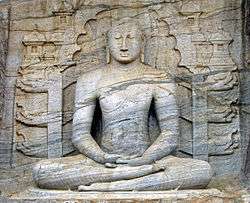Patisambhidamagga
| Part of a series on |
| Theravāda Buddhism |
|---|
 |
| Pāli Canon |
|---|
| Vinaya Pitaka |
| Sutta Pitaka |
| Abhidhamma Pitaka |
The Patisambhidamagga (paṭisambhidā-; Pali for "path of discrimination"; sometimes called just Patisambhida for short; abbrevs.: Paṭis, Pṭs) is a Buddhist scripture, part of the Pali Canon of Theravada Buddhism. It is included there as the twelfth book of the Sutta Pitaka's Khuddaka Nikaya. Tradition ascribes it to the Buddha's disciple Sariputta. It comprises 30 chapters on different topics, of which the first, on knowledge, makes up about a third of the book.
History
Tradition ascribes the Patisambhidamagga to the Buddha's great disciple, Sariputta.[1] The text was dated by A.K. Warder to approximately 3rd century BCE. According to German tradition of Indology this text was likely composed around the 2nd century CE.[2] L.S. Cousins in his review of Hinuber's overview of Pali literature notes that such a late dating must be a mistake based on unawareness of A.K. Warder's results, according to which the Patisambhidamagga represent an earlier stage of development of thought than Theravada canonical Abhidhamma treatises.
The Patisambhidamagga has been described as an "attempt to systematize the Abhidhamma" and thus as a possible precursor to the Visuddhimagga.[2]
Emptiness
The Patisambhidamagga is probably the first Pali Abhidhamma text which uses the term "sabhava" in the section titled the Suññakatha.[3] It defines sabhava as the empty (suññam) nature of the five aggregates:
"Born materiality is empty of sabhava (sabhavena suññam); disappeared materiality is both changed and empty. Born feeling is empty of sabhava; disappeared feeling is both changed and empty...Born conceptualization...Born volitions...Born consciousness...Born becoming is empty of sabhava; disappeared becoming is both changed and empty. This is ‘empty in terms of change’."
According to Noa Ronkin: "this extract means that the totality of human experience is devoid of an enduring substance or of anything which belongs to such a substance, because this totality is dependent on many and various conditions, and is of the nature of being subject to a continuous process of origination and dissolution."[4]
Overview
The Patisambhidamagga has three divisions (vagga) composed of ten "chapters" (kathā) each for a total of thirty chapters. The three divisions are:
- Mahāvagga ("Great Division") - starts with an enumeration (mātikā) of 73 types of knowledge (ñāṇa) which are then elaborated upon in detail.
- Yuganandhavagga ("Coupling Division") - poses a series of questions.
- Paññāvagga ("Wisdom Division") - answers the prior division's questions.[2]
Translations
Translation: The Path of Discrimination, tr Nanamoli, 1982, Pali Text Society, Bristol
In addition, Mindfulness of Breathing, tr Nanamoli, 1998 (6th ed.), Buddhist Publication Society, Kandy, Sri Lanka, includes a translation of the Anapanakatha in the Patisambhidamagga, along with the Anapanasati Sutta and other material from Pali literature on the subject.
Notes
- ↑ This ascription can be found in the Pali commentary to the Patisambhidamagga (Paṭis-a I 1,18) (Hinüber, 2000, p. 60).
- 1 2 3 Hinüber (2000), p. 60.
- ↑ Ronkin, Noa; Early Buddhist Metaphysics, page 92
- ↑ Ronkin, Noa; Early Buddhist Metaphysics, page 92
Sources
- Hinüber, Oskar von (2000). A Handbook of Pāli Literature. Berlin: Walter de Gruyter. ISBN 3-11-016738-7.